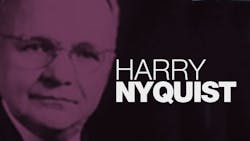Harry Nyquist: A Founding Father Of Digital Communications
When electrical engineers hear the name "Nyquist," they think of what Harry Nyquist is best known for: his Sampling Theorem. Evidence of its importance is everywhere. Products like cell phones, audio CDs, and iPods are all based on the broad-shouldered foundation of the theorem, and that alone is enough to place Nyquist among the industry's greats. But Harry Nyquist had many other, lesser known accomplishments, a number of which resonate strongly today.
Harry Nyquist was born in 1889 in Sweden. Impressed by Nyquist's intelligence, a teacher encouraged him to go to America, where there was greater opportunity. Nyquist arrived in the U.S. in 1907 and subsequently earned BSEE and MSEE degrees from the University of North Dakota in 1912 and 1915, respectively, and a PhD in physics from Yale University in 1917.
In 1917, Nyquist joined the American Telephone and Telegraph Company, delving into the work of improving telegraph picture and voice transmission. His department was folded into Bell Telephone Laboratories in 1934, which allowed him to continue his work in transmission engineering until his retirement in 1954. He built an impressive body of work during his 37 years with the communications giant, represented by his 138 U.S. patents and a dozen published technical articles.
As early as 1918, Nyquist had begun attempts to adapt telephone circuits for transmission of images. By 1924, AT&T had something it termed "telephotography," or what we'd call a facsimile machine. Despite a cruder method of execution, it used the same principles as today.
A photographic transparency was mounted on a spinning drum and scanned. The data was then transformed into electrical signals that were proportional to the shades and tones of the image. Next, the data was transmitted over phone lines and deposited onto a similarly spinning sheet of photographic negative file, which was developed in a darkroom. Incidentally, the first faxed images were 5- by 7-in. photos sent from New York City to Cleveland. Each photo took seven minutes to transmit.
Throughout the 1920s, Nyquist broke new ground in solving the communications issues of the day. In 1927 he extended the work of J.B. Johnson and developed a mathematical explanation for thermal noise, now known variously as Johnson or Nyquist noise.
The beginnings of modern information theory are found in the body of his work. In a 1924 paper in the Bell System Technical Journal, Nyquist first referred to what was transmitted by telegraphers as "information." He suggested that two factors determined the "maximum speed of transmission of intelligence."
Those factors were the signal's shape (a square wave was deemed superior to a sine wave) and the choice of code used to represent the intelligence. Using maximum Morse-code telegraphy speed as a starting point, Nyquist eventually determined that the maximum speed of intelligence transmission is proportional to the logarithm of the number of symbols that need to be represented.
Nyquist's most significant work was his 1928 paper, "Certain Topics In Telegraph Transmission Theory." It refined his earlier work on improving transmission speed. More importantly, though, it brought into focus Nyquist's theoretical work on the bandwidth requirements for data transmission and the basics of sampling continuous analog signals and converting them to digital form, now better known as the Nyquist Sampling Theorem.
Sampling Theorem
According to the Sampling Theorem, an analog signal must be sampled at regular intervals over time and at twice the frequency of its highest-frequency component to be converted into an adequate representation of the signal in digital form. Thus, the "Nyquist frequency" is the highest frequency that can be accurately sampled. It represents one-half of the sampling frequency. Adhering to the Nyquist Sampling Theorem ensures no lost data upon reconstruction in the analog domain.
Once again, Nyquist drew upon Morse code as a model to establish a way to digitally encode an analog signal using ones and zeros. A side benefit of this work was his invention of the codec circuit used to perform the coding and decoding of the analog signal.
Nyquist's work was enormously influential to the communication engineers that followed him. This was especially true of his Bell Labs colleague,-Claude Shannon, considered by many to be the father of information theory. Nyquist's 1924 and 1928 papers were cited in the first paragraph of Shannon's own claim to greatness, the 1948 paper titled "The Mathematical Theory of Communications."
Numerous experts say that Nyquist stated the Sampling Theorem, and Shannon later mathematically proved it. Moreover, many believe that Nyquist and Shannon are responsible for virtually all theoretical advances in modern communications.
In the early 1930s, Nyquist began looking into negative-feedback amplifiers and how to determine when they become stable. His findings resulted in the development of the Nyquist Stability Theorem. During World War II, the theorem helped control artillery that used electromechanical feedback systems. An outgrowth of Nyquist's work in feedback loops was the "Nyquist plot," which plots the magnitude and phase of a frequency response on orthogonal axes.
After his retirement, Nyquist became a part-time consultant, providing communications expertise to the Department of Defense and private defense electronics firms. He received many honors for his communications work. For example, he was the fourth recipient of the National Academy of Engineers' Founder's Medal.
Yet Nyquist never saw the full fruits of his labor. He died in 1976, years before the debut of the technology needed to make digital audio recording and playback a reality, and ultimately an enormous commercial success.
